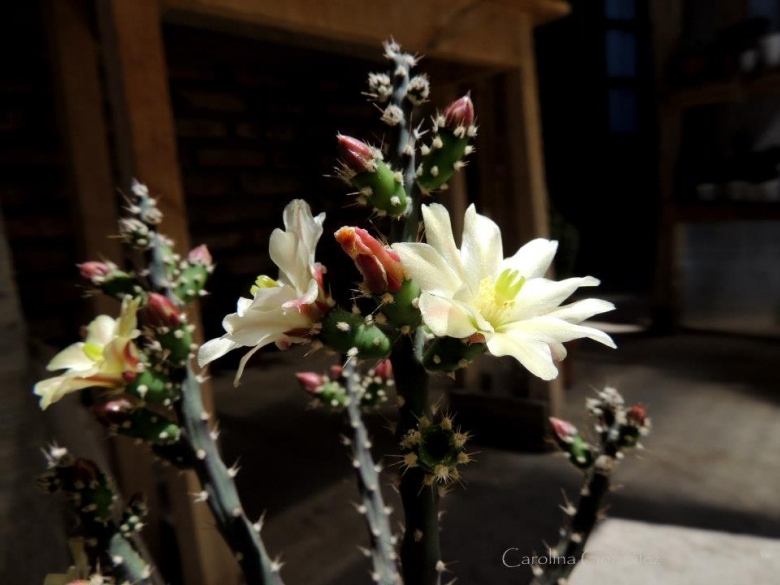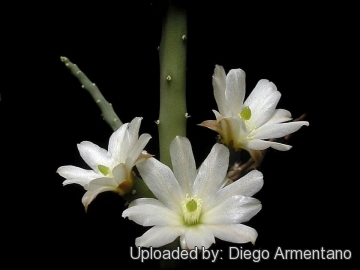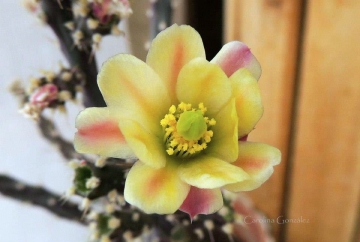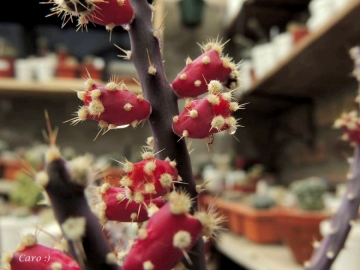




Your support is critical to our success.
Cactaceae (Berlin) ; Jahrb. Deutsch. Kakt.-Ges. 1941, Pt. 2, 13 (1942); cf. Gray Herb.Card Cat.
Family: CACTACEAE

Origin and Habitat: Austrocylindropuntia salmianaSN|4029]]SN|4029]] is native to Paraguay (Boquerón and Alto Paraguay departments), Bolivia, and northern Argentina (Catamarca, Córdoba, Entre Ríos, Jujuy, Salta, Santiago del Estero, Santa Fe, and San Luis provinces). It has been cited for southern Brazil, but this is likely a mistake.
Elevation range: This cactus occurs at elevations between 100 and 1,500 metres above sea level.
Habitat and Ecology: This species may occur in alkaline soils and rocky areas in the Sierras Pampeanas. It occurs in the border of the xerophilous Chacoan forest, particularly in the transition between Humid Chaco and Dry Chaco regions. This species is not used or commercialized. It is invasive in many areas. It is favored by livestock grazing, as it is dispersed by adhering itself to the fur of animals. It can be locally abundant in many areas, and there are no known threats affecting it.
Synonyms:
- Austrocylindropuntia salmiana (J.Parm. ex Pfeiff.) Backeb.
- Cylindropuntia salmiana (J.Parm.) F.M.Knuth in Backeb. & F.M.Knuth
- Opuntia salmiana J.Parm. ex Pfeiff.
- Platyopuntia salmiana (Pfeiff.) F.Ritter
- Salmonopuntia salmiana (Pfeiff.) P.V.Heath
Austrocylindropuntia salmiana (J.Parm. ex Pfeiff.) Backeb.
Cactaceae (Berlin) ; Jahrb. Deutsch. Kakt.-Ges. 1941, Pt. 2, 13 (1942); cf. Gray Herb.Card Cat.
Synonymy: 18
- Austrocylindropuntia salmiana (J.Parm. ex Pfeiff.) Backeb.
- Cylindropuntia salmiana (J.Parm.) F.M.Knuth in Backeb. & F.M.Knuth
- Opuntia salmiana J.Parm. ex Pfeiff.
- Platyopuntia salmiana (Pfeiff.) F.Ritter
- Salmonopuntia salmiana (Pfeiff.) P.V.Heath
- Austrocylindropuntia ipatiana (Cárdenas) Backeb.
- Opuntia ipatiana Cárdenas
- Salmonopuntia salmiana f. rosea P.V.Heath
- Austrocylindropuntia salmiana var. albiflora (K.Schum.) Backeb.
- Austrocylindropuntia albiflora (K.Schum.) Backeb.
- Opuntia albiflora K.Schum.
- Salmonopuntia salmiana f. alba P.V.Heath
- Austrocylindropuntia salmiana var. spegazzinii (F.A.C.Weber) G.D.Rowley
- Austrocylindropuntia spegazzinii (F.A.C.Weber) Backeb.
- Cylindropuntia spegazzinii (F.A.C.Weber) Backeb.
- Opuntia salmiana var. spegazzinii (F.A.C.Weber) G.D.Rowley
- Opuntia spegazzinii F.A.C.Weber in Bois
- Salmonopuntia salmiana f. glauca P.V.Heath
Description: AustrocylindrSN'>4029' alt='4031'>Opuntia salmiana#SN#4031'>Austrocylindr[[Opuntia salmianaSN' style='border:none;'>SN|4029]], formerly known as Opuntia salmiana, is a shrubby Opuntia 3 dm. to 2 meters high, much branched at base. The large yellow flowers contrast beautifully with the red-purple of the young stems. It flowers freely even when grown indoor. Strikingly enough, in AustrocylindrSN'>
4029' alt='4031'>Opuntia salmiana#SN#4031'>Austrocylindr[[Opuntia salmianaSN' style='border:none;'>SN|4029]] the fruits are highly proliferous; each lateral fruit may break off the receptacle and form a new plant; fruits of this species do not contain seeds and reproduction is completely vegetative.
Stems: Branches (segments) often weak, cylindrical, terete, up to 25 cm long and 1.5 cm in diameter or less, deep blue-green often purplish, not tuberculate.
Areoles: Small, bearing wool, yellow glochids and spines
Spines: Sometimes wanting, usually several, to 1.5 cm long or less, white.
Flowers: 2 to 3.5 cm broad, scattered along the stem. Buds pinkish or even scarlet. Petals obovate, pale yellow to white, sometimes tinged with pink; stamens and style short. Stigma-lobes yellowish green
fruits: Sterile, clavate, scarlet, spineless or nearly so. The fruits have the capacity to develop roots and shoots, behaving like seedlings in this way.
Bibliography: Major references and further lectures
1) N. L. Britton, J. N. Rose: “The Cactaceae. Descriptions and Illustrations of Plants of the Cactus Family.” Vol I, The Carnegie Institution of Washington, Washington 1919
2) Stefen Bernath “The Cactus Coloring” Courier Corporation, 1981
3) Oakley, L. & Pin, A. 2013. Opuntia salmiana. The IUCN Red List of Threatened Species. Version 2014.3. <www.iucnredlist.org>. Downloaded on 10 April 2015.
4) Ingrid Roth “Fruits of angiosperms” Gebr. Borntraeger, 1977
5) Ingrid Roth “Handbuch der Pflanzenanatomie” Volume 10, Part 1 Borntraeger, 1977
6) Willy Cullmann, Erich Götz (Dozent Dr.), Gerhard Gröner “The encyclopedia of cacti” Timber Press, 1987
7) Urs Eggli, Leonard E. Newton: “Etymological Dictionary of Succulent Plant Names.” Springer, Berlin/Heidelberg 2010
8) David Hunt, Nigel Taylor “The New Cactus Lexicon” DH Books, 2006
9) James Cullen, Sabina G. Knees, H. Suzanne Cubey “The European Garden Flora Flowering Plants: A Manual for the Identification of Plants Cultivated in Europe, Both Out-of-Doors and Under Glass” Cambridge University Press, 11/August /2011

Austrocylindropuntia salmiana Photo by: Diego Armentano

Austrocylindropuntia salmiana Photo by: Carolina González

Austrocylindropuntia salmiana Photo by: Carolina González

Austrocylindropuntia salmiana Photo by: Carolina González

Austrocylindropuntia salmiana Photo by: Carolina González

Austrocylindropuntia salmiana Photo by: Carolina González
Cultivation and Propagation: Austrocylindropuntia salmianaSN|4029]]SN|4029]] is a semi-hardy cactus easily found in cultivation. Make sure your Austrocylindropuntia is not exposed to temperatures below -4°C or it may die. Nevertheless it is a good advice never let the night-time temperature fall below 5°C. It is a summer grower species that offers no cultivation difficulties. Growing this cactus in a container or pot restricts its growth. This species is not self-fertile and must be propagated from cuttings. Note that this South American plants have a tendency to spread and sterile fruits that break off can start new plants in adjacent pots. These are fun plants for kids to have and experiment with and provide a good lesson in plant propagation.
Soil: Use a very a particularly draining substratum, as it is sensitive to rottenness when in presence of humidity and low temperatures and let the soil dry out between waterings, since it's natural habitat is in sandy or gravelly, well draining soils.
Repotting: Repot in the spring, when their roots become cramped. Generally, they should be repotted every other year in order to provide fresh soil. After repotting, do not water for a week or more.
Water: In summer, during the vegetative period, it must be regularly watered, but allowing the substratum to completely dry up before irrigating again (but do not overwater ); in winter, it’s to be kept dry. Preferable not to water on overcast days, humid days or cold winter days.
Hardiness: It is dslightly frost resistant cactus, hardy to -4° C if very dry. However in cultivation it is better not to expose it to temperatures lower than -5° C, even if in an aerated and protected location, in order to avoid the formation of anti-aesthetic spots on the epidermis. In presence of high atmospheric humidity avoid any frost as it is sensitive to root rot. USDA Zone 9-10. It can handle extremely high temperatures in summer.
Exposure: Outside full sun or afternoon shade, inside needs bright light, and some direct sun.
Use: It is suitable for “desert” gardens, in association with other xerophytes. Where the open air cultivation is not possible due to the climate, it is to be cultivated in pot in order to shelter it in winter.
Propagation: Stem division. Prickly pear pads root easily and grow rapidly when placed in loose, well-draining soil.
Warning Handle with care! The little glochids at the base of the spines are quite a nuisance and the minimal touch may be fatal. It is best to use gloves to handle this plant.
| Your Actions | |
|---|---|
| Back to Austrocylindropuntia index | |
| Back to Cactaceae index | |
 |
Back to Cacti Encyclopedia index |
Privacy stantement - Terms and conditions - How to cite - About us - Feedback - Donate



